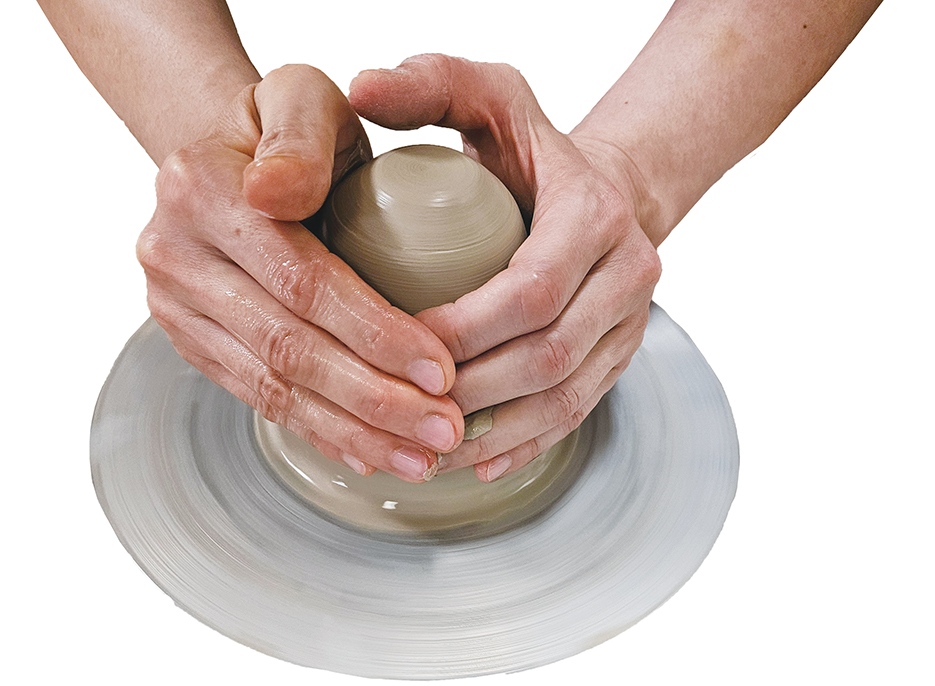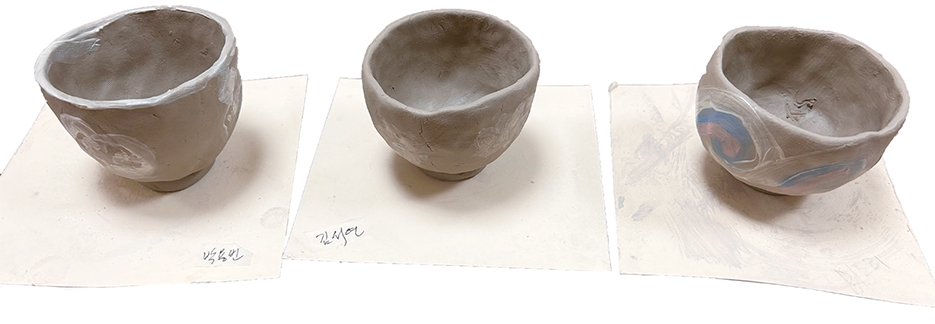The Chungbuk Times > Global > View
Make a Tradition of Pottery in Bukchon
제 222 호 발행일 : 2025.06.02

Korean traditional pottery is a practical art that has endured for thousands of years. Starting from simple earthenware in the early days, it has developed into a cultural heritage with both artistry and functionality today. Walking through the alleys of Bukchon, CBT reporters could encounter workshops and experience centers that convey the long history. The CBT reporters visited the Bukchon Traditional Craft Experience Center to experience the world of pottery firsthand and discover its value.

History of Korean Traditional Pottery
Traditional Korean pottery is not just a living tool, but an art with thousands of years of history and aesthetics. From earthenware and roof tiles of the Three Kingdoms period of Korea to the celadon of Goryeo and the white porcelain of Joseon Dynasty, unique beauty and technology have developed in each era. The earliest pottery began as simple, practical crafts made by firing clay. Still, over time, they evolved into more elaborate and diverse forms through the application of glaze and precise control of kiln temperatures.
In particular, Goryeo celadon gained international renown for its bluish-green glaze and the delicate sang-gam inlay technique. The sang-gam technique involves carving designs into the surface of the pottery and then filling the carved areas with black or white clay to complete the patterns. Moreover, the white porcelain of the Joseon Dynasty embodies the essence of Korean pottery with its simple yet restrained aesthetic. The pure white hue of Joseon white porcelain resonates with the Confucian values emphasized during that era, reflecting a serene beauty found in natural simplicity.
Traditional Korean pottery encompasses a wide variety of forms. In addition to everyday items such as teacups, bowls, jars, and vessels were also made for ancestral rites and Buddhist ceremonies.
Living Tradition in the City: Bukchon Traditional Craft Experience Center
In the heart of Seoul, there is a place where the spirit of tradition remains alive and well. Located in Gye-dong, Jongno-gu, the Bukchon Traditional Craft Experience Center is a public facility operated by the Jongno District Office. It serves as a cultural space where visitors can see, learn, and experience the beauty and spirit of Korean traditional crafts firsthand.
Located within the Bukchon Hanok Village, the experience center is housed in a serene traditional hanok building. It features eight permanent workshops specializing in traditional techniques such as gold-leaf art, knotting, embroidery, glass art, line drawing, and pottery. These workshops take turns offering hands-on programs each week.
When the CBT reporters visited on Friday, a regular pottery class was in session, allowing tourists and locals to try their hand at making traditional pottery such as teacups and moon jars.
Despite the gloomy weather on the day the CBT reporters visited, foreign tourists continued to arrive without pause. Japanese tourists Sayuri and Atsuko, who were exploring Bukchon Hanok Village during their first visit to Korea, said they had stopped by the center. Although they did not participate in the hands-on experience, they commented, “The quiet atmosphere left a strong impression,” and expressed a desire to try the experience next time. Ahn So-yeon, a potter who teaches the weekly pottery classes, explained, “There are more foreign visitors than Koreans,” adding that “Many come either to participate in the workshops or simply to tour the hanok style space.”
Teacups and Moon Jars
The CBT reporters participated in a pottery experience program at the Bukchon Traditional Craft Experience Center and experienced making teacups and moon jars. Two teacups could be made at a time, and the moon jars were made using a water wheel for trial. The cost for the trial program was 40,000 KRW and 50,000 KRW, respectively.
Pottery production begins with the Subi stage. Subi refers to finely grinding soil, dispersing it in water, sifting it, and collecting the sediment to dry it in the shade. Subsequently, water is added to the dried soil to remove air and soften the texture. This process is called Toryun. It is commonly applied to both teacups and moon jars.
As the CBT reporters participated in the trial program, they were provided with clay that had already gone through Subi and Toryun and were able to experience it firsthand from the next step. The experience center explained that it uses white pottery soil, which is less refined, so that people can handle it easily.
Molding is the next step in pottery making. Molding is the process of creating the shape of the pottery. Teacups are shaped with fingers and palms. First, cut the corners by rounding the clay and press the center with thumb to make a hole. Then, the hole is gradually widened and in the thickness uniform, the opening is thin and the inside is rounded to make it easier to hold in hand.
In this process, the CBT reporters realized that creating the shape of a teacup was not as easy as expected. This is because, unlike ordinary clay, which was mainly dealt with, white pottery clay was relatively hard, so it took more effort to make the shape.
Moon jars are shaped on a device called a spinning wheel during the molding stage. A spinning wheel is a tool that spins the clay to shape pottery. Generally, moon jars are completed by making and attaching two hemispheres at the top and bottom separately, but in this trial, only one hemisphere was made.
When the CBT reporters first turned the spinning wheel, it was not as easy to maintain a stable posture as it looked. It was not just to rotate the clay, but to form the right shape, and high concentration and delicate fingertip control were required. In particular, it was impressive to see the process of spinning the clay and gradually changing into a circular shape, and to experience the shape changing with the lightest touch.
After the shape is completed, the next step is where patterns or decorations are engraved on the surface of pottery using a carving knife. Since it was a trial program, teacups were made by painting simple patterns using traditional paint instead of carving. After the sculpting is finished, the pottery is slowly dried to remove moisture completely, and then fired at a temperature of about 850ºC to 900ºC. After that, in the step of Siyu, glaze is applied to color it, and finally, by putting it in a high-temperature kiln of 1200ºC to 1300ºC, the pottery is completed.
With a production process taking approximately two weeks, the experience center is designed to allow to experience each stage firsthand, right up to the sculpture phase.

Tradition felt with fingertips, the spirit of a pottery
Taiwanese tourists Angela and Irena, who experienced the pottery program together at the Bukchon Traditional Craft Experience Center, said, “It was a very novel experience to be able to make traditional Korean pottery by handling the clay.” Angela said, “I have never experienced making pottery in Taiwan, but it was very amazing to be able to experience it for the first time in Korea. It was a meaningful time to feel the beauty of Korea with my hands and understand the tradition indirectly.” In particular, she expressed satisfaction by saying, “I think this experience will remain an unforgettable memory on my first trip to Korea.”
Potter Ahn who met at the Bukchon Traditional Craft Experience Center, invited the CBT reporters to her craft shop in person for a more meaningful visit. At the craft shop, not only were traditional pottery techniques preserved and inherited, but pottery that added a modern sense was also being produced steadily. “More people are visiting the craft shop these days. I feel proud that the interest in pottery is increasing,” Ahn said. “It is good to see the welcoming attitude of learning about modern pottery as well as our traditional pottery spirit.” She added, “I hope that modern people will continue to pay attention to traditional pottery in the future.” Potter Ahn’s craft shop, Ceramic Dodo is located in Seochon.
After completing the traditional pottery experience, the CBT reporters gained a deep appreciation for the craftsmanship and dedication of potters, realizing that no step in the process is truly simple. The delicate precision required to shape the clay, the meticulous control of the fingertips, and the thoughtful finishing touches revealed the depth of traditional culture beyond just a hands-on activity. Though brief, the experience served as a meaningful reminder of the immense value found in the skilled hands of artisans and the expertise honed over generations.
By Kim Seo-yeon
ssung@chungbuk.ac.kr
By Park Yong-bin
2021014006@chungbuk.ac.kr